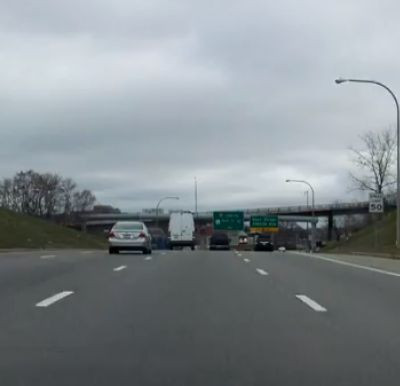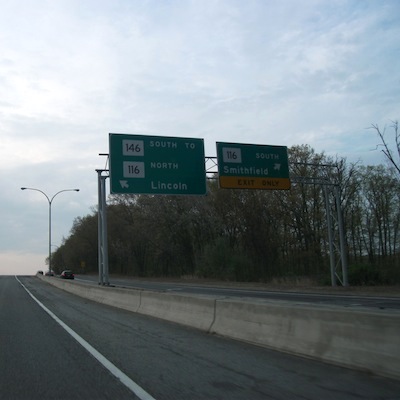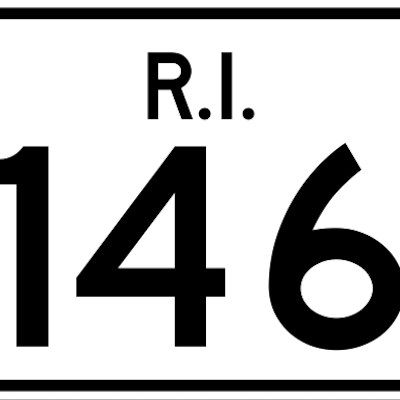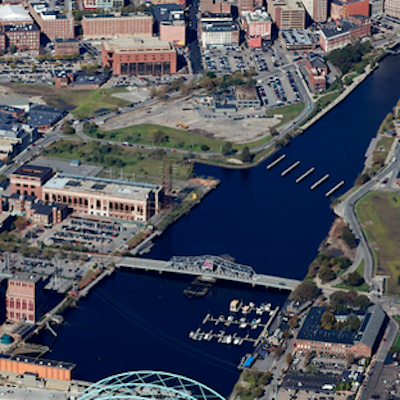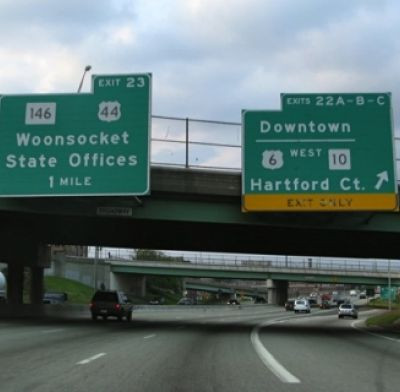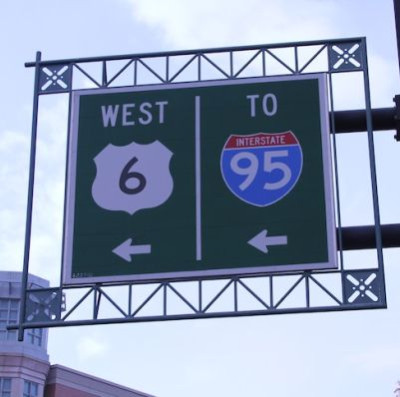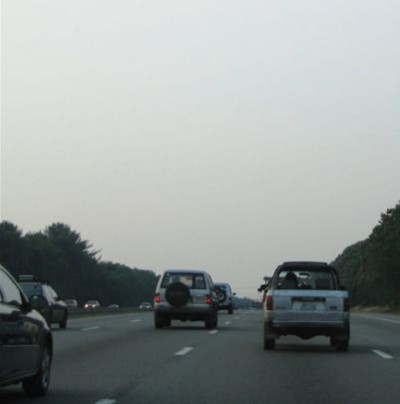Bishop: 6/10 Connector - The $800 Million Mile
Thursday, March 31, 2016
The Governor and DOT used a rope a dope strategy for the tolls in which toll opponents essentially accepted the DOT list of road projects. Opponents simply sought to reprioritize existing money to bridge repairs or proposed using existing collection methods, such as the Diesel tax, to enhance revenues from trucks while saving the cost of tolling gantries. Those were good arguments but not winning. The debate from the outset should have been: what possible justification can there be for spending $800 million dollars on a mile of highway to nowhere?
Now that isn’t to say that Providence, Cranston and Johnston are nowhere, but nowhere in the sense that limited access highways are generally conceived as connecting distant points. Indeed the 6/10 Connector was meant to be the terminus of I-84 from Hartford, which was the first highway to be nixed by the anti-highway movement in Rhode Island. Typically, that didn’t stop DOT from building what really was meant to be the last mile of I-84.
Last week a team of ‘experts’ was convened in Providence as a re-opening shot in the debate over what to do with this most expensive mile of road in Rhode Island. It is not entirely unhealthy that the era of rapid highway expansion has ended, albeit a shame that DOT Director Alviti announced at this forum that DOT plans no expansion in the next decade.
GET THE LATEST BREAKING NEWS HERE -- SIGN UP FOR GOLOCAL FREE DAILY EBLASTSome roads that arguably would serve industry, tourism and the state’s academic fabric, such as the connection between 95 and the Jamestown bridge which also provides access to URI and the missing southern link to the Quonset Industrial Park were not built. Others, that were less important, or possibly counterproductive, like the 6/10 Connector made it under the wire.
But the Providence forum was interested in more than simply no expansion. The city appears to be joining the latest effort to throw the highway building transmission from neutral into reverse. All indications are that the Mayor and the City Council are on the same page here, supporting removal rather than replacement of the 6/10 Connector. A surface level boulevard offering street level access to Olneyville, Federal Hill and downtown would take its place.
It’s not surprising to see a progressive municipal government joining the chorus of new urbanists. While conservatives should be in no rush to pile on to some end of highways as we know them, their concerns for fiscal responsibility should have them looking seriously at joining the other side in this instance. It is the budget busting character of the DOT’s planned rebuilding of the 6/10 Connector that fueled the toll debate. If the 6/10 Connector is removed, so should be the toll gantries, before they are ever built!
A funny thing happened on the way to the forum
Providence was so concerned about making the case for a different approach, that they overshadowed concerns from other communities served by the 6/10. Planners from other towns are convinced that the favorable treatment given to highway removal strategies was an oversimplification. Fiscal conservatives are, in this view, in danger of being coopted by an anti-car, anti-development mentality undercutting RI’s economic future.
The knee-jerk argument for the Connector’s continued necessity is that 97,000 cars a day now pass over it. But this road was only opened in the early 90s. Last we looked Cranston and Johnston were not only important residential but important commercial centers before that. How could they possibly have sustained their economies before this mile of highway was opened, if it cannot be done without?
Still, the panelists treated this loss of capacity offhandedly, suggesting those who currently travel the 6/10 Connector will simply find another way. They could cite real world examples such as portions of the West Side Highway in New York collapsing requiring 140,000 motorists to instantly find alternative routes to what was considered a vital urban highway. That motorists succeeded on their own, with no planning and without manifesting the expected 24/7 gridlock in the area, catalyzed some transit engineers to think more seriously about the self organizing nature of traffic density and route planning.
But a self organizing paradigm cuts both ways. The 20 years of the availability of the 6/10 Connector have affected development and produced business and commuting patterns that have a degree of dependence on that piece of road. It is cavalier to speak the language of new urbanism in a way that flippantly dismisses those concerns.
Thus this forum in Providence, that was an incredible success with several hundred coming out to share widespread support for a different direction on this project, was an incredible failure for not more seriously engaging skepticism. The panel was stacked and made DOT Director Alviti appear ganged up on. And his response was predictably status quo, to present pictures of yet more infrastructure -- covering the 6/10 corridor with greenspace and turning what is already an insupportably expensive undertaking into RI’s big dig!
Minds are changed over time by thoughtful exchange. Brute force control of the podium is not a pathway to good policy. Of course these are the methods the Governor and the General Assembly used to force through truck tolls and to endorse an incredible waste of money on the 6/10 Connector. It is tempting for those looking for a change in direction to think turnaround is fair play.
But, if the modernists were wrong in tearing down historic urban structures in favor of indecorous concrete mausoleums and fracturing neighborhoods with urban highways in order to connect one series of these monstrosities to the next, why should we assume the new urbanists are right? They are just the latest bunch who want to be the folks “here from the government to help us”. Their prescriptions should be challenged in ways that the Modernists were not. Skepticism is healthy. Plenty has been expressed for the state DOT, but this does not mean that an alternative shouldn’t receive equally harsh scrutiny.
It’s not Olneyville vs. Arlington and Neutaconkanut
Cranston and Johnston should not be left with the impression that Providence is unconcerned with the importance of the 6/10 Connector to the economy of any other communities. Providence has a similar stake in this outcome. Does anyone really think Providence would put up with crippling access to downtown employment, retail and tourism in the name of improving the lot of Olneyville? The terminus of the 6/10 Connector which would be removed is, after all, the Providence Place Mall. The Dean Street exits are convenient access to Federal Hill and to the eastern extent of mill renovations along the Woonasquatucket.
Providence would naturally be concerned about maintaining the same level of economic access to all these features and believes that is possible with a boulevard. But the process currently lacks serious consideration of how commuters and commerce use that mile to connect to Cranston and Johnston. Will the obvious alternatives, e.g. Route 10’s southern terminus with 95, Route 6’s major interchange with 295 together with a strong network of arterial surface roads and a Boulevard along the course of the existing Connector provide equivalent service to their economies? There are plenty more forums to come.
Sometimes The Best Plan Is The Least Costly Plan – even in RI
Few would disagree that Olneyville deserves a leg up. If that could be accomplished by cutting transportation spending and eliminating tolls rather than by community development corporatism with handouts of various sorts costing the state and the city additional hundreds of millions of dollars, that would be a win-win.
But those proposing to remove the highway have to demonstrate not just a concern for Olneyville, but a calibrated regard for other industry and commerce served by the 6/10 Connector. Equally, those proposing to make this ‘pedestrian’ bit of state road into the biggest public works project in state history should be held to account for the cost/benefit of such outrageous spending.
Cart before the Horse
The real criticism of state officials here should not be of their plan for the 6/10 Connector, which was adopted in good faith decades ago, but their blind reliance on this antique blueprint to force through truck tolls and an ungodly commitment to spending $800 million on an effort that has lost its relevance.
We are headed for the Uber society, for self driving cars, for changes in industrial pursuits and residential patterns. A 20 year old plan these days just about came from the horse and buggy era. One lesson we should take from that time is: don’t put the cart before the horse.
Why wasn’t the process begun by this forum held before stampeding legislators into voting to fund the old plan? The public and the legislature, albeit on different terms, signaled a commitment to necessary infrastructure. The argument is: what is necessary here? That is far too important to have been left as an afterthought.
Truck Tolls are not the answer for the 6/10 Connector
Ironically, the administrative flexibility in Rhodeworks tolling that caused suspicion amongst opponents, as well as the concern that future legislatures could change legislation – perhaps leading eventually to car tolls -- inure to the benefit of those seeking the best policy outcomes here.
Who should pay for this undertaking is clearly in question as DOTs own traffic counts for the toll debate actually demonstrate that this is not a truck route. Truck traffic is an order of magnitude lower on the 6/10 Connector than on the interstates, representing but 1% of daily trips! Any administrative process should take cognizance of that meaning that cost/benefit is going to be a major driver of outcomes, as it should be.
No plans for locating toll gantries should be made before we determine whether the 6/10 Connector should be rebuilt or unbuilt.
Brian Bishop is on the board of OSTPA and has spent 20 years of activism protecting property rights, fighting overregulation and perverse incentives in tax policy.
Related Slideshow: RI’s Most Dangerous Bridges
The American Road and Transportation Builders Association recently released a list of the most traveled, deficient bridges in each state. In Rhode Island, those bridges were:
Related Articles
- Women & Infants to Study Postpartum Depression in Teens
- New RI Web Site Ties Legislatures Failure to Economy - www.OSTPA1.com
- Research Shows Teen Moms at Higher Risk for Postpartum Depression
- Bishop: Transformation – So Far it’s All Talk in Providence
- Bishop: Taylor Swift Move Over
- Bishop: Keeping the Pawtucket Red Sox Without Seeing More Red in Providence
- Bishop: What Do The State House & Downton Abbey have in Common? An abiding sympathy for King Canute
- Brian Bishop: Rhode Island Energy Policy: The Gift That Keeps on Taking
- Brian Bishop: A Turning Point in RI: Will Voters Approve a Constitutional Convention?
- Bishop: With ‘help’ like this…? - State Policy For Providence A One-Way Street
- Bishop: Bridges, Tolls and a Tale of Three States
- Bishop: Calm Yorke More Outrageous Than Brash Trump
- Bishop: For Whom the Bill Tolls
- Bishop: 38 Stabilizations - Neverending Prov Tax Giveways are 38 Studios Redux
- Bishop: The Soft Under Belly of Rhodeworks - A Connector to Nowhere
- Brown Grad Williams Elevated to Bishop Designate
- Bishop: Labor Piece Agreements . . . as in Piece of The Pie
- Bishop: Hitchhikers Guide to Vaccine Mandates
- Bishop: Constitution Day at Brown - What’s the State of Our More Perfect Union?
- Bishop: Post-Toll Impasse Between Public and Political Will





